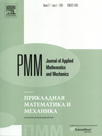 | | Journal of Applied
Mathematics and Mechanics
Russian Academy of Sciences | | Founded
in January 1936
(Translated from 1958)
Issued 6 times a year
ISSN 0021-8928
(print version) |
Archive of Issues
| Total articles in the database: | | 10610 |
| In Russian (ΟΜΜ): | | 9811
|
| In English (J. Appl. Math. Mech.): | | 799 |
|
| << Previous article | Volume 81, Issue 5 / 2017 | Next article >> |
| I.G. Brykina and G.A. Tirskiy, "Mass loss and light curve of a large meteoroid. Analytical solution," J. Appl. Math. Mech. 81 (5), 395-408 (2017) |
| Year |
2017 |
Volume |
81 |
Issue |
5 |
Pages |
395-408 |
| DOI |
10.1016/j.jappmathmech.2018.03.008 |
| Title |
Mass loss and light curve of a large meteoroid. Analytical solution |
| Author(s) |
I.G. Brykina (Institute of Mechanics, Lomonosov Moscow State University, Moscow, Russia, shantii@mail.ru)
G.A. Tirskiy (Institute of Mechanics, Lomonosov Moscow State University, Moscow, Russia) |
| Abstract |
The interaction of a large meteoroid with the Earth's atmosphere is considered in the case when it moves as a single body and when it moves as a cloud of fragments with a common shock wave. Using the literature data, an expression has been obtained for the radiative heat transfer coefficient per unit area of the midsection of a meteoroid modelled by an oblate spheroid as a function of its velocity, size, the atmospheric density, and its oblateness coefficient. The regions of predominant influence of the convective and radiative fluxes are estimated. An expression is obtained for the drag coefficient of a spheroid. Assuming that the mass of the meteoroid decreases faster than its velocity, analytical solutions of equations of the physical theory of meteors have been obtained for the mass loss of a meteoroid of spheroidal shape, the profile of the light curve, and the altitude at which the maximum of this curve is reached. The fragmentation model, which considers the meteoroid as a cloud of fragments with the spaces between them filled by a vapour, expanding in the lateral directions and flattening in the flight direction with a rate that depends on the degree of expansion is proposed. Using this model and the analytical solutions obtained, the interaction of the Chelyabinsk meteoroid with the atmosphere is considered. Good agreement between the found solution for the profile of the light curve and the observed data-light curves based on different video recordings-is demonstrated down to an altitude of 27 km. |
| Keywords |
major axis; free stream velocity; plasticity and yield |
| Received |
04 April 2017 |
| Link to Fulltext |
|
| << Previous article | Volume 81, Issue 5 / 2017 | Next article >> |
|
 If you find a misprint on a webpage, please help us correct it promptly - just highlight and press Ctrl+Enter If you find a misprint on a webpage, please help us correct it promptly - just highlight and press Ctrl+Enter
|
|

 Russian
Russian  English
English